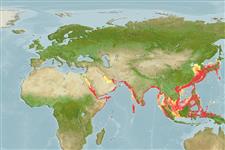Environment: milieu / climate zone / depth range / distribution range
Ecology
Marine; freshwater; brackish; demersal; oceanodromous; depth range ? - 800 m (Ref. 100719), usually ? - 300 m (Ref. 9942). Subtropical; 47°N - 4°S, 30°E - 143°E (Ref. 54598)
Indo-West Pacific: Red Sea, Persian Gulf, west coast of India, and Sri Lanka to Fiji and Tuvalu (Ref. 12596), north to Japan and Korea, south to the Arafura Sea (Ref. 9819) and northern Australia. Migrated to the Mediterranean via the Suez Canal (Ref. 6724).
Size / Weight / Age
Maturity: Lm ? range ? - ? cm
Max length : 220 cm TL male/unsexed; (Ref. 559); common length : 80.0 cm TL male/unsexed; (Ref. 3397); max. reported age: 15 years (Ref. 72462)
Dorsal spines (total): 0; Anal spines: 0; Vertebrae: 145 - 159. Snout long; eye diameter 2-2.5 times in snout length; posterior nostrils much closer to eyes than to anterior nostrils; mouth very large; teeth generally large and conspicuous (Ref. 4832). Head broader, interorbital about 8 times in head; lateral-line pores before anus 44-47; dorsal-fin rays before anus 66-78; vertebrae 145-159 (Ref. 9830).
Body shape (shape guide): eel-like.
Occurs from the littoral zone to the upper bathy-benthic region (Ref. 9942, 11230). Inhabits soft bottoms (Ref. 11230), also found in estuaries. Sometimes enters freshwater environment (Ref. 9987). Feeds on small bottom fishes and crustaceans. Captured and cultured for fishery in Japan. Marketed mainly fresh (Ref. 7238). Also used as bait for shark fishing (Ref. 2872). Also caught by bag (dol) nets. Used in Chinese medicine (Ref. 12166).
Masuda, H., K. Amaoka, C. Araga, T. Uyeno and T. Yoshino, 1984. The fishes of the Japanese Archipelago. Vol. 1. Tokai University Press, Tokyo, Japan. 437 p. (text). (Ref. 559)
IUCN Red List Status (Ref. 130435: Version 2025-1)
Threat to humans
Harmless
Human uses
Fisheries: highly commercial; aquaculture: commercial; gamefish: yes; bait: occasionally
Tools
Special reports
Download XML
Internet sources
Estimates based on models
Preferred temperature (Ref.
123201): 11.6 - 23.2, mean 17.4 °C (based on 401 cells).
Phylogenetic diversity index (Ref.
82804): PD
50 = 0.6250 [Uniqueness, from 0.5 = low to 2.0 = high].
Bayesian length-weight: a=0.00427 (0.00162 - 0.01121), b=3.06 (2.84 - 3.28), in cm total length, based on LWR estimates for this (Sub)family-body shape (Ref.
93245).
Trophic level (Ref.
69278): 4.4 ±0.67 se; based on food items.
Generation time: 5.8 ( na - na) years. Estimated as median ln(3)/K based on 1
growth studies.
Resilience (Ref.
120179): Medium, minimum population doubling time 1.4 - 4.4 years (Tmax=15; K=0.19-0.33; Min Rel Fec=153).
Prior r = 0.57, 95% CL = 0.37 - 0.85, Based on 3 data-limited stock assessments.
Fishing Vulnerability (Ref.
59153): High vulnerability (62 of 100).
🛈
Climate Vulnerability (Ref.
125649): Very high vulnerability (85 of 100).
🛈
Nutrients (Ref.
124155): Calcium = 30.7 [16.9, 59.0] mg/100g; Iron = 0.831 [0.484, 1.436] mg/100g; Protein = 19.1 [16.9, 21.6] %; Omega3 = 0.339 [0.157, 0.993] g/100g; Selenium = 66.3 [35.3, 123.9] μg/100g; VitaminA = 6.96 [2.12, 22.85] μg/100g; Zinc = 0.412 [0.295, 0.612] mg/100g (wet weight);
